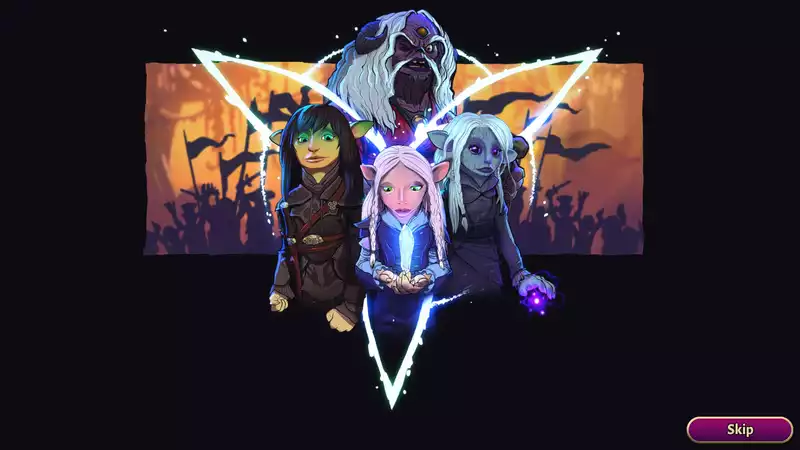I love strategy games, and I love "The Dark Crystal," but when it came to adapting the Netflix TV series into a movie, I was quite skeptical of the idea of putting the two together. While "Age of Resistance Tactics" doesn't do full justice to the combination, it is a much richer and fuller game than I had anticipated.
For those unfamiliar, the show (spun out of a 1982 cult film) is set in a bizarre fantasy world represented primarily by puppetry and animatronics, where small, peaceful Gelflings are oppressed by screeching, parasitic skexis The game loosely recreates this story. The game loosely retells this story, with a few new developments of its own, but it is so jumbled and fleeting that those who have not seen the series will be completely lost from beginning to end.
The storytelling falls mostly flat, with too little explanation for beginners and not enough new elements to please fans looking for important additions to the canon. Where the game shines, however, is in the action.
As you progress through the campaign map, you assemble a party of heroes and fight in turn-based battles with a combination of familiar and newly added characters from the show. Thanks to clear presentation, a simple interface, and plenty of undo buttons, the strategy is very straightforward, yet complex enough to sustain a surprisingly long play time of 20 hours.
There are hints of "through the breach" in the mission design (relax, it's only a hint), and careful positioning and maneuvering are the keys to success. Attacking from above your opponent gives you an attack bonus and prompts you to fight from a higher position. Environmental hazards, such as poisoned swamps and broken gobble holes, will damage those who stop there. Move and push abilities can be used to line up enemies and push them into danger, but it is vital not to leave soldiers unprotected by the same trick.
The stages become more and more clever as you progress, and your sense of strategic design comes into play. On the coastal islands, one must watch out for the tides, which can rise and drown hapless combatants, or ebb and flow, exposing new routes. In the dungeons of Skeksis, the party is split into two routes, each finding and hitting a lever that opens the door to the other.
There is a surprisingly extensive character customization system to adapt to each challenge. The JRPG-style "job" system, reminiscent of Final Fantasy and Dragon's Dogma, effectively allows heroes to switch between classes at will and level up in each discipline individually. Abilities gained in one class can be used as secondary powers in another, allowing players to create their own hybrid classes and unlock advanced tier 2 and 3 jobs by meeting certain requirements. Combinations can range from as simple as paladin/thief to as esoteric as chef/beast tamer.
Although leveling up slows as a character's total experience increases, otherwise wrong choices are not punished. Oddly enough, however, they are not bound by canon. Characters have natural inclinations, but there is nothing to stop you from turning a peaceful nature-loving Deet into a ruthless assassin, for example, or a resistance hero Lian into a bookish scholar. Whether that's a bit of goofy fun or outright sacrilege will depend on your inclinations as a fan.
The more time you spend playing around with the roster, the more interesting combos you will find. Many abilities can only be used when certain buffs and debuffs offered by other classes are applied, and can be rewarded through clever synergy. For example, targets marked by scouts are easy prey for slow-moving but powerful soldiers, and song tellers can easily deploy multiple buffs at once, making the musician's powerful "ultimate solo" more reliable and successful. Random "event" missions serve not only as a way to level up, but also as a simple testing ground for finding one's own unique combination.
There is a kind of toy-box fun in collecting the show's heroes, dressing them up as you like, and having them fight for your own amusement. But they feel like toys, lacking the physicality and vitality of on-screen puppets. This is partly due to the limitations of the medium. According to a behind-the-scenes documentary on the show, the original plan was to produce the game entirely in CGI, but the creators soon realized that the character designs were nothing more than puppets. In a way, this game tackles the same problem. But this is also clearly a symptom of a low budget, as the game attempts to bring the bustling world of Sula to life with a very limited selection of animations and character models.
Similarly, the strategic combat is fun throughout, but the relationship to the original story is mixed to say the least. The fight with Chamberlain recalls the show nicely. He uses honey traps to distract and confuse the heroes. But the presentation of Blair's search for knowledge as a brutal skirmish with a squad of librarians who must collect giant floating books by pounding on them is awkward at best. The battles are fun, but rarely did an hour pass without some in-game reminder that the dark crystal is not an ideal genre for a film adaptation.
Still, the fact that it is enjoyable is a testament to the game's strategic nature. It won't rock anyone's world, but as a tie-in to an inexpensive television show, it has its own appeal, and it's a fun opportunity for fans of the series to spend a few hours with the Gelflings.
.

Comments